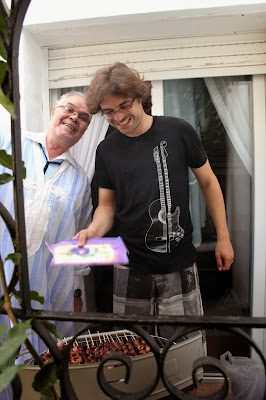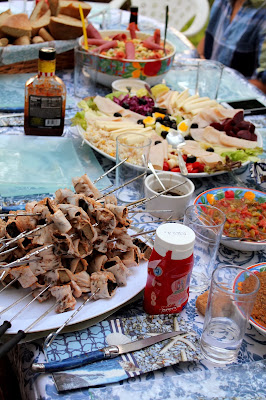Sheep generally are up for sale in tents all around Casablanca (and I guess Morocco in general but can't really say that for sure since I haven't witnessed it). If it's not a tent it's a garage or something of the sort that gets turned into a holding pen, which double as "sheep hotels" for those which have already been bought, but whose owners don't want on their balconies just yet.
It’s a very family centered holiday, and we spent it with Othman’s mom, dad, sister Sarah and brother Omar, along with some of their closer extended family at his parents’ beach apartment. The apartment is in a large complex which meant there were many sheep being slaughtered that day. It seemed haphazardous, but really was quite orderly, and was organized by the security guards. In past years the smell of sheep and blood and feces wafting through their house has really bothered me, so I was happy the slaughtering/holding of the sheep was done away from the house this year.
In the pictures you can see the holding pen, and how the scale was really pretty large. One family apparently doesn’t really like mutton and opted to slaughter a cow, and another family, possibly one with less money, went for a goat instead. It’s my understanding that both of these were also one-year-old males, but I may be wrong. The prices of the sheep vary greatly depending on its size and all that, but 2000 Moroccan dirhams, about $240, was the general starting point this year. Any household that would go into debt or have financial difficulty to buy a sheep is not supposed to get one, but that is ignored a lot of the time, since there’s a hefty amount of social pressure to have your own sheep.
In the afternoon we all eat the big meal with the traditional dishes and salads. One delicacy, and one of Othman’s favorites, is the sheep’s balls chopped up and cooked with lots of butter. I’m not a huge meat eater and don’t really like mutton, so I mainly eat salad. Needless to say, I don't partake in my hubby's favorite. The next day there’s usually another family get-together with shish-kebobs of the more tender meat and whichever of the dishes were leftover from the day before.
 |
| O and his uncle manning the barbecue |
 |
| Our Eid group (I'm behind the camera) |
Of course this is just my personal experience from the 3 Eid al Kebirs I have spent here. Traditions vary from family to family, region to region, so I can't speak for all of Morocco, but here's one expat's version!
 |
| Behind is a Russian salad brought by Othman's aunt (in pink above), and in front is a traditional dish made from the three sheep stomachs.... |
I stayed away from the blood and guts in this post, but if you like that kind of stuff I have some more pictures on my Flickr.








No comments:
Post a Comment